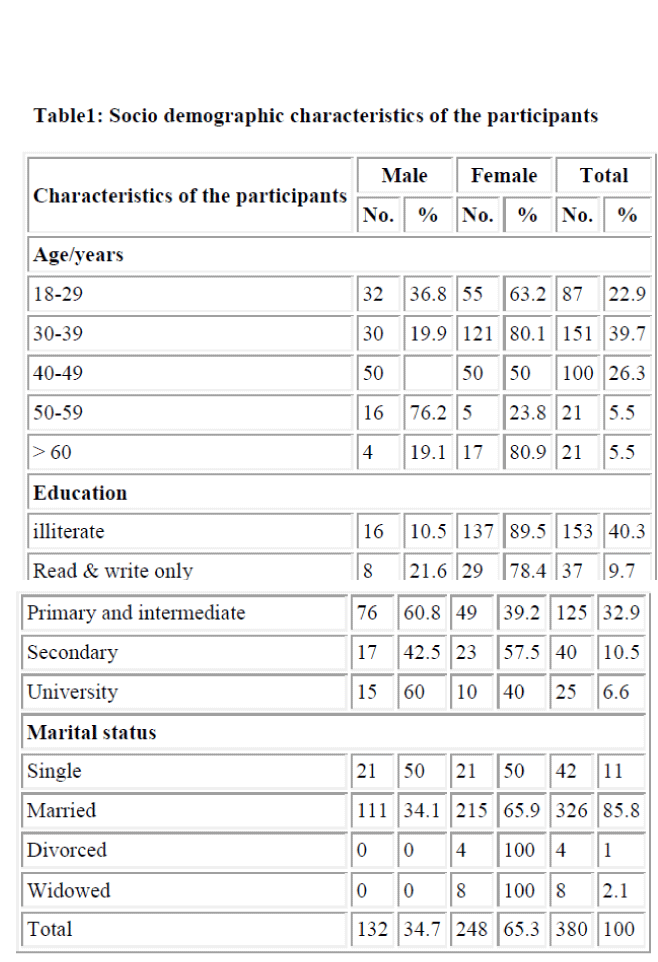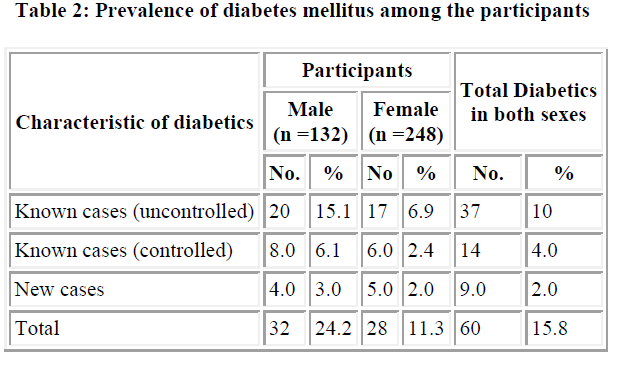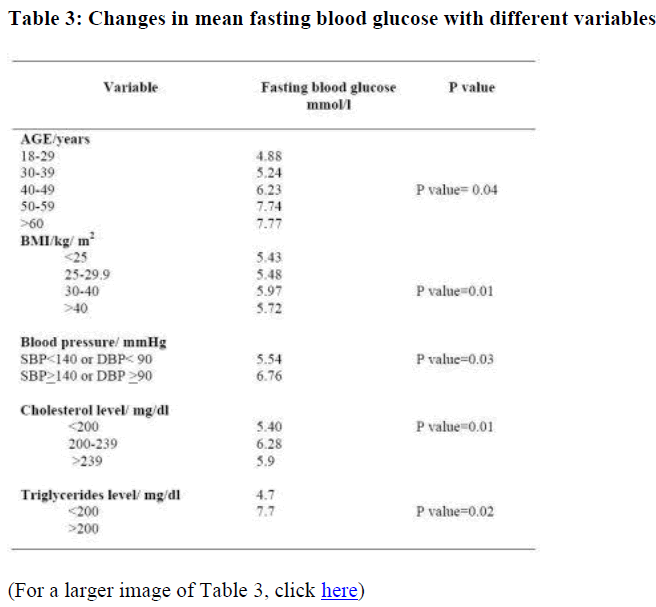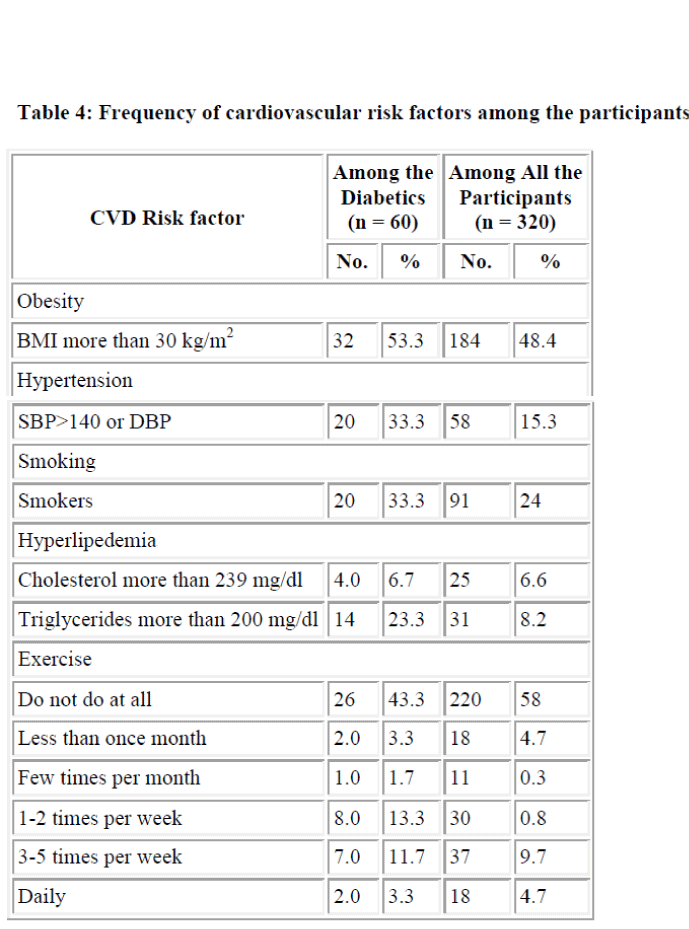ISSN: 0970-938X (Print) | 0976-1683 (Electronic)
Biomedical Research
An International Journal of Medical Sciences
- Biomedical Research (2007) Volume 18, Issue 3
Diabetes Mellitus - Prevalence and associated cardiovascular risk factors in a Saudi suburban community
Saleh M. Al Osaimi *, Khalid S. AL-Gelban**
1*ytiC lacideM zizA ludbA gniK ,enicideM ytinummoC dna ylimaF fo tnemtrapeD Riyadh, Saudi Arabia
2** dilahK gniK ,enicideM fo egelloC ,enicideM ytinummoC dna ylimaF fo tnemtrapeDUniversity, Abha, Saudi Arabia
- Corresponding Author:
- Khalid S. Al-Gelban
Department of Family and Community
Medicine College of Medicine, King Khalid University
P.O. Box 641 Abha, Saudi Arabia
Tel: 0096672247800 Ext 2203
Fax: 0096672247570
e- mail: khalidgelban (at ) hotmail.com
Accepted date: July 31 2007
The study was undertaken to determine the prevalence of diabetes mellitus and its risk factors among the attendees of primary health care centers in a Saudi suburban community. A cross-sectional survey was conducted during March and April 2002. Out of eight satellite clinics, four clinics were selected by using systematic random sampling. All 451 attendees older than 18 years were included in the study sample, but 71 of them refused to undergo the blood investigations. Thus, three hundred eighty (380) subjects were screened for diabetes mellitus and associated cardiovascular risk factors including the assessment of lifestyle, obesity, hypertension, smoking and hyperlipidemia. The prevalence of diabetes mellitus was found to be 15.8% (24.2% in males and 11.3% in females) only 23.3% of them were well controlled. Fifteen percent (15%) of the diabetics were undiagnosed. The mean fasting plasma glucose increased significantly with increase in age (p= 0.04), BMI (p= 0.01), blood pressure (p= 0.03), cholesterol level (p= 0.01) and triglycerides level (p= 0.02). No statistical significant association with frequency of exercise (p=0.50) was observed. Diabetes mellitus and associated cardiovascular risk factors are prevalent in the study population, which are more among males as compared to females. An early detection program for diabetes mellitus and associated cardiovascular risk factors is needed. Such a program will contribute to the improvement of quality of life of the population.
Keywords
Diabetes mellitus, risk factors, prevalence, primary health care centers, Saudi Arabia
Abstract
The study was undertaken to determine the prevalence of diabetes mellitus and its risk factors among the attendees of primary health care centers in a Saudi suburban community. A cross-sectional survey was conducted during March and April 2002. Out of eight satellite clinics, four clinics were selected by using systematic random sampling. All 451 attendees older than 18 years were included in the study sample, but 71 of them refused to undergo the blood investigations. Thus, three hundred eighty (380) subjects were screened for diabetes mellitus and associated cardiovascular risk factors including the assessment of lifestyle, obesity, hypertension, smoking and hyperlipidemia.
The prevalence of diabetes mellitus was found to be 15.8% (24.2% in males and 11.3% in females) only 23.3% of them were well controlled. Fifteen percent (15%) of the diabetics were undiagnosed. The mean fasting plasma glucose increased significantly with increase in age (p= 0.04), BMI (p= 0.01), blood pressure (p= 0.03), cholesterol level (p= 0.01) and triglycerides level (p= 0.02). No statistical significant association with frequency of exercise (p=0.50) was observed. Diabetes mellitus and associated cardiovascular risk factors are prevalent in the study population, which are more among males as compared to females. An early detection program for diabetes mellitus and associated cardiovascular risk factors is needed. Such a program will contribute to the improvement of quality of life of the population.
Introduction
Patients with diabetes have an increased incidence of atherosclerotic cardiovascular, peripheral vascular and cerebrovascular diseases [1]. Rates of diabetes have been rising around the world [2]. Globally, an estimated 150 million people are affected with diabetes and the number is likely to reach at least 300 million by the year 2025 [3]. In U.S. the prevalence among adults increased from 4.9% in 1990 to 6.5% in 1998 [4].
Undiagnosed diabetes is not a benign condition. Many of the complications present at the time of diagnosis to the same or a greater as in diagnosed diabetes [5]. Fifty percent of patients with diabetes mellitus in the United States, and 58.5% in Singapore are undiagnosed [5,6].
Evidence from several studies indicates that obesity, undergoing rapid changes in lifestyle, hypertension and abnormalities of lipoprotein metabolism are often found in people with diabetes [1,7,8,9].
The prevalence of diabetes mellitus in the western countries is about 3-7% [10] while in South Africa the prevalence of diabetes mellitus is 7.1% [11]. In the neighboring country, Oman, King et al [12] have reported that the prevalence of diabetes mellitus is 13.1% [12].
In Saudi Arabia, the prevalence of diabetes mellitus has been observed as 11.8% and 12.8% for males and females, respectively [13]. The prevalence of diabetes mellitus in the age group of 35 years and above is found to be 8.52% in males and 19.48% in females in a study conducted in a Saudi military hospital population [14], while the overall prevalence of diabetes mellitus is found to be 23.7%, males 26.7% and females 21.5%, respectively in the age group of 30-70 years in the general population of the Kingdom of Saudi Arabia. [15].
Most of Saudi citizens have direct access to primary health care services. All the chronic diseases including diabetes mellitus are managed at this level [16]. It is, therefore, important that physicians working in the primary health care centers are to be aware of the magnitude of diabetes mellitus and its associated cardiovascular risk factors among their patients to ensure them, the better care.
It has become an essential component of the anticipatory health care of the Saudi community which has a younger population structure (60% of them are less than 30 years and 47% of them are less than 15 year old, only 4% are 65 years old or older [17].
Therefore, the aim of the present study is to determine the prevalence of diabetes mellitus and associated cardiovascular factors among the patients who have attended the primary health care centers in a sub urban Saudi community.
Material and Methods
This cross sectional study was conducted during the March and April 2002 on the patients who attended the primary health care centers (PHCCs) - King Abdul Aziz City for National Guard Housing (KACNGH). KACNGH is situated at the east of Riyadh, with a total population of 55000. Most of them are related to the settlers of nomadic families.
KACNGH has a central polyclinic and eight satellite clinics. Four of the satellite clinics were selected using systematic random sampling technique. Patients older than 18 years were interviewed by 4th year family medicine residents. For each individual participant, age, sex and history of smoking were noted. Height and weight for the calculation of Body Mass Index (BMI) were recorded. Blood pressure was also measured. The participants were instructed to visit the polyclinic laboratory when they were fasting for at least 12 hours for blood tests including fasting blood sugar (FBS) and lipid profile.
Prior to the completion of questionnaire and conducting various measurements and lab tests, purpose of the study was described to all participants. They were clearly informed that they could choose not to participate or to withdraw at any time during the study. They were assured of anonymity and confidentiality.
Height was measued without shoes to the nearest of 0.1 centimeter (cm) using a stadiometer. Weight was measured to the nearest of 0.1 kg on a bathroom scale with the subject wearing light clothes and with no shoes. BMI was claculated as weight (kg) divided by the square of the height (m2). Obesity was defined as a BMI of > 30 kg/m2 [18].
Each subject was asked to take rest for at least 10 minutes in the supine position before recording the systolic and diastolic blood pressures. Another measurment of blood pressure was taken after the interview, using the same mercury sphygmomanometer and by the same doctor. Blood pressure was measured using cuff of a size appropriate to the arm circumference in accordance with the recommendations of the British Hypertension Society [19]. Hypertension was defined as systolic blood pressure >140 mmHg and/or diastolic blood pressure >90mmHg [20]. The scales and sphygmomanometers were checked regularly.
Fasting blood samples were drawn for the determination of FPG and serum lipid levels. Specimens of blood for FPG were collected in fluoride oxalate tubes and determined by the hexokinase enzymatic method while blood for lipids was collected in plain vacutainer tubes and serum concentrations of total cholesterol and triglycerides were determined by the enzymatic methods.
The diagnosis of diabetes mellitus was based on the American Diabetes Association (ADA) Expert committee of the Diagnosis and Classification of Diabetes Mellitus recommendations (diabetes mellitus [FPG ≥ 7.0 mmol /l], impaired fasting glucose [IFG 6.1-7.0 mmol /l], and nondiabetic FPG 6.1 mmol/l. Patients who showed fasting blood sugar above 7mmol/l were instructed to revisit the clinic for diagnosis and for proper management.
Cholesterol and triglyceride levels were classified according to the National Cholesterol Education Program (NCEPIII) third report [21]. Hypercholesterolemia is defined as 239 mg /dL or more, and hypertriglyceridemia as 199 mg /dL or more.
Statistical analysis was carried out using Statistical Package for the Social Sciences (SPSS v.11) software package and appropriate tests were used at the 5% level of significance.
Results
A total of 451 subjects were initially enrolled, 71 of them were excluded because, they refused for blood testing giving a response rate of 84.3%. There was no significant difference in age or gender from those who completed the study.
The mean age of the participants was 36.2 (SD±11.16 years). Table 1 shows that, around two thirds of the participants were in the age group of 18-39 years while about 10% were older than 50 years. The study sample had a female predominance (sex ratio M:F= 1: 1.9). The females were less educated as more than half of them were illiterates. However, no statistical significant relationship between illiteracy and prevalence of diabetes mellitus was observed.
Table 2, shows that the overall prevalence of diabetes mellitus was 15.8% (24.2% in males, 11.3% in females; P =0.003). Fiftyone of them (85%) were confirmed cases of diabetes mellitus and nine subjects (15%) were new cases. Twentyeight subjects of the non diabetics (7.3%) were found to have IFG.
Table 3 shows that the mean FBG increases significantly with an increase in age, BMI, blood pressure, levels of cholesterol and triglycerides. A statistical significant association was detected between obesity and diabetes mellitus (p= 0.01) with poor correlation (r= -0.131) the mean FBG was 5.54 mmol/l in normotensive and 6.76 mmol/l for hypertensive subjects (p= 0.03) with a fair correlation between the prevalence of diabetes and systolic and diastolic blood pressure (r= 0.27) and(r= 2.4), respectively. There was a statistically significant relationship between FBG and both cholesterol (p= 0.01) and triglyceride (p= 0.02), respectively.
Table 4 shows that 48.4% were obese comparing with 53.3% of diabetics. One third of the diabetics were hypertensive comparing with only 15% of non diabetics. One third of diabetics were smokers comparing with a quarter of non diabetics. Among diabetics, hypercholesterolemia and triglyceridemia were found to be 6.7% and 23.3% , respectively.
28 participants (7.3%) had impaired fasting glucose (IFG)
(For a larger image of Table 3, click here)
BMI: Body Mass Index; SBP: Systolic Blood Pressure; DBP: Diastolic Blood pressure
More than 40% of diabetics did not do any kind of exercise, while only 15% of them did physical exercise for 3 times or more per week. However, no statistical significant relationship between frequency of exercise and the prevalence of diabetes mellitus (p=0.50) was observed.
Discussion
The purpose of this study was to determine the prevalence of diabetes mellitus and its associated cardiovascular risk factors among the patients of PHCSs in a sub urban community in Saudi Arabia. The results indicate that diabetes mellitus and the associated cardiovascular factors are widely prevalent.
Unlike the majority of previous studies, this study population is the descendant of rural or tribal communities, which has the advantage of revealing the magnitude of diabetes and cardiovascular risk factors among the community, which is less educated, and less exposed to civilization. In addition, it can be a representative for other military housing populations in Saudi Arabia and in neighboring countries. Most of the military housing populations have almost the same dietary habits, do the same levels of physical activities and have descended from the same rural or tribal communities. However, these results cannot be generalized and applied to the Saudi community in general.
The results revealed that the prevalence of diabetes mellitus is 15.8% (24.2% in males and 11.3% in females, which was calculated in accordance with to the ADA criteria (1997) might underestimate the prevalence as compared to WHO criteria using OGTT test. ADA criteria bring a slightly lower prevalence than the WHO (1985), criteria with moderate agreement (k= 0.65) [22].
Fatani et al, reported that, the prevalence of diabetes in rural and urban populations in the Western Province of Saudi Arabia among those over the age of 15 years was 6.6% and 7.8%, respectively [23,24]. These early studies were done in 1985 where civilization and sedentary life style were less prevalent as compared to the present age. El-Hazmi et al, reported the prevalence of diabetes in Saudi Arabia in the age group of 14-70 years is 9.73% in males and 7.06% in females [25]). In 1995 Al-Nuaim et al using WHO criteria reported that, 12% (11.8% in males and 12.8% in females) of Saudi population were diabetics [13]. In the neighboring country, Oman, which has similar demographic and cultural characteristics like Saudi Arabia, the prevalence of diabetes, was found to be 13.1% in males and 12.8% in females [12]. In Singapore and Hong Kong the prevalence of diabetes among adult population was 8.4% and 9.8%, respectively [22, 5] comparing with the USA and other western countries around 7% [10, 26]. The higher prevalence of diabetes among males in this study could be explained by the presence the younger age group of females as only 8% of them were above 50 years comparing to 14% of males. Al Nozha et al also observed the similar findings [15].
Undiagnosed diabetics were found to be only 15% comparing with 50% and 58.5% in USA and Singapore, respectively [27]. This could be attributed to the underestimation of the prevalence of diabetes by using ADA criteria.
This study is in agreement with previous work, where there is a significant increase in the frequency of diabetes with increase of age, BMI, blood pressure and lipid level. El-Nuaim et al reported an increase in blood pressure by 6% per one year increase in age (13). Al Hazmi et al reported that 57.67% of male diabetics and 69.0% of female diabetics were overweight (BMI=25-29.9 kg/m2) or obese with a BMI > 30 kg/m2 (28). El-Hazmi et al observed a positive correlation between blood glucose, total cholesterol and triglyceride levels [29].
Only 10.9% of diabetics were smokers and there was no relationship between diabetes and smoking. Information on the relation between cigarette smoking and risk of diabetes is limited [30].
In this study, there was no significant relationship found between the prevalence of diabetes and physical activity (P=0.50) even it was mentioned by some researchers that men engaged in moderate level of physical activity had a substantially reduced risk of diabetes [31].
Conclusion
This study confirmed that there is a high prevalence of diabetes among the patients of PHCCs and the prevalence is increased with age, BMI, blood pressure and hyperlipedemia. Screening for diabetes and associated cardiovascular risk factors should be intensified, as early detection will contribute in decreasing the risk of diabetes and its associated cardiovascular risk factors.
Acknowledgement
The author would like to thank Dr. Mohd. Yunus Khan of the Department of Family & Community Medicine, College of Medicine, King Khalid University for his help in reviewing the manuscript and Mr. Allan I. Agaton for his secretarial assistance.
References
- Expert Committee on the Diagnosis and Classification of Diabetes Mellitus. Report of the Expert Committee on the Diagnosis and Classification of Diabetes Mellitus. Diabetes care, January 2002; 25: S5-S20.
- Cruickshank JK. Epidemiology and geography of non-insulin dependent diabetes. In: Textbook of Diabetes. Pickup JC, Williams G, 2nd ed., Oxford, U.K: Blawell; 1997, p 17-29.
- King H, Aubert RE, Herman WH. Global burden of diabetes, 1995 - 2025: Prevalence, numerical estimates, and projections. Diabetes Care 1998; 21: 1414-1431.
- Mokdad AH, Ford ES, Bowman BA, et al: Diabetes trends in the United States, 1990 - 1998. Diabetes Care 2000; 23: 1278-1283.
- Tai ES, Lim SC, Tan BY, et al. Screening for diabetes mellitus - a two step approach in individuals with impaired fasting glucose improves detection of those at risk of complications. Diabet Med 2000; 17: 771-775.
- American Diabetes Association. Screening for type 2 diabetes. Diabetes Care 2004; 27: S11-S14.
- Ford ES, Williamson DF, Liu S. Weight changes and diabetes incidence: Findings from national cohort of US adults. Am J Epidemiol 1997; 146: 214-222.
- Resnick H, Valsania P, Halter J, et al. Relation of weight gain and weight loss on subsequent diabetes risk in overweight adults. J Epidemiol Community Health 2000; 54: 596-602.
- Kawate R, Yamakido M, Nishimoto Y, et al. Diabetes mellitus and its vascular complications in Japanese migrants on the island of Hawaii. Diabetes Care 1979; 2: 161-170.
- Harris M I,Zimmet P.classification of Diabetes Mellitus and other categories of glucose Intolerance. International Textbook of Diabetes Mellitus.2nd ed. Chichester: Wiley;1997, p 9-23.
- Levitt NS, Steyns K, Lambert EV, et al. Modifiable risk factors of Type 2 diabetes mellitus in a periurban community in South Africa. Diabet Med 1999, 16, 946-950.
- King H, Rewers M. Global Estimates for prevalence of diabetes mellitus and impaired glucose tolerance in adults. Diabetes Care 1993; 16: 157-177.
- Al-Nuaim A, Al-Rubeaan K, Al-Mazrou Y, et al. National chronic metabolic diseases survey 1995. Jointly published by: Ministry of Health and King Saud University. Kingdom of Saudi Arabia 1997: p23-54.
- Karim A, Ogbeide DO, Siddiqui S, et al. Prevalence of diabetes mellitus in Saudi community. Saudi Med J 2000; 21: 438-442.
- Al-Nozha MM, Al-Maatouq MA, Al-Mazrou YY, et al. Diabetes mellitus in Saudi Arabia. Saudi Med J 2004; 25: 1603-1610.
- Badawi I, Khattab M, Cambell J. Referrals rates and patterns in primary care departments, Khamis Mushyt, Saudi Arabia, Saudi Med J 1998;19:157-61.
- Khoja TA, Farid SM. Saudi Arabia Family Health Survey 1996: Principal Report. Riyadh: Ministry of Health 2000.
- National Institutes of health. Clinical guidelines on identification, evaluation, and treatment of overweight and obesity in adults.Obes Res; 2:S51-S209.
- British Hypertension Society. Technique of blood pressure measurement. J Hypertension 1985; 3: 293-312.
- American Diabetes Association: Standards of medical care for patients with diabetes mellitus. Diabetes care 2002; 25: S33-S49.
- Expert Panel on Detection, Evaluation, and Treatment of High Blood Cholesterol in Adults. Executive Summary on the Third Report of the National Cholesterol Education Program (NCEP)Expert panel of detection, evaluation,, and treatment of high blood cholesterol in adults (Adult Treatment Panel III). JAMA 2001; 285: 2486-2497.
- Janus ED, Watt NM, Lamt KS, et al. The prevalence of diabetes, association with cardiovascular risk factors and implications of diagnostic criteria (ADA 1997 and WHO 1998) in a 1996 community based population study in Hong Kong Chinese. Hong Kong Cardiovascular Risk Factors Steering Committee. American diabetes Association. Diabetic Med 2000; 17: 741-745.
- Fatani HH, Mira SA, El-Zubier AG.The prevalence of diabetes mellitus in urban Saudi Arabia. Third Proceedings of World Congress on Diabetes in the Tropics and Developing Countries, Bangkok: Crystal House 1985: 8-16.
- Fatani HH, Mira SA, El-Zubier AG. The prevalence of diabetes mellitus in rural Saudi Arabia. Diabetes Care 1987; 10: 180-183.
- El-hazmi MAF, Warsy AS, Al-Swailem AR, et al. Diabetes mellitus and impaired glucose tolerance in Saudi Arabia. Ann Saudi Med 1996; 16: 381-385.
- American Diabetes Association. Management of Dyslipidemia in Adults with Diabetes. Diabetes Care 2001; 24: S58-S61.
- World Health Organization: Diabetes Mellitus Report of a WHO Study Group. Geneva, World Health Org, 1985 (Tech. Rep. See. No 727).
- El-Hazimi MAF, Warsy AS. Prevalence of obesity in Saudi population. Ann Saudi Med 1997; 17: 302-306.
- El-Hazmi MAF, Al-Swailem AR, Warsy AS, et al. Lipid and Related Parameters in Saudi Type 2 Diabetes Mellitus Patients. Ann Saudi Med 1999; 19: 304-307.
- Feskens EJ, Kromhout D. Cardiovascular risk factors and the 25 year incidence of diabetes mellitus in middle aged men: the Zutphen Study. Am J Epidemiol 1989; 130: 1101-1108.
- Perry IJ, Wannamethee SG, Walker M, et al. Prospective study of risk factors for developmet of non-insulin dependent diabetes in middle aged British men. BMJ 1995; 310: 560-564.



